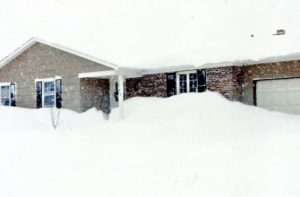Writing from Experiences

Since the temperatures in North Carolina are in the nineties, I chose to write about the two times I got caught in a white-out snowstorm in upstate New York. Writing from these personal experiences recently helped me. Those times provided me with great details to include in my new Ella in America series.
Before the first storm started, my husband, John, and I walked around the golf course near our home. John noticed a black cloud forming over Lake Ontario. Moments later, a chilling October wind blew and the temperature dropped.
A sudden gust sent hundreds of dried leaves tumbling across the road. The motion made them look alive. I stopped in mid-step. Did my eyes deceive me, or was that hundreds of mice scurrying away from something? Would they run over me? I shivered at the thought. Then as I walked closer, I realized they were only dead leaves propelled by the wind.
Snowflakes soon accompanied the wind, so we hurried home. As we ran back, houses along the way vanished in the ensuing white-out storm. We persevered through the bad weather until we arrived at our place, but we had to brush several inches of snow off our clothes before we entered the house.
The second white-out storm was much worse. On that day, my daughter and I pushed a baby carriage down the street to visit a friend only one mile away. The weather in Rochester was unusually pleasant for January – seventy degrees and sunny.
Although the weatherman had not predicted bad weather, the kids and I left my friend’s house early when I spotted a dark cloud. As I walked home, clouds covered the sun. Then the temperature dropped an amazing fifty degrees in the next five minutes!
I wrapped the baby in a warm blanket and pushed the carriage as fast as I could. The temperature was now twenty degrees, and snowflakes fell all around us. A biting wind blasted against my face and made me gasp for breath. I shielded my daughter from it with my body.
More flakes fell, faster and faster until everything had turned white. The snow swirled around me, and the neighbor’s houses disappeared in a cloud of white. Snow fell so quickly, I couldn’t see even my hand in front of my face.
I did not know which direction was home, but I kept the carriage wheels going straight ahead. Soon the wheels became harder to push. Three inches of snow had covered the ground, and no traffic had passed by to leave tracks. As the storm worsened, I carried my three-year-old daughter while I plowed ahead with the carriage.
When we finally reached our property, I still had to push the carriage another one hundred and fifty feet down our driveway. With a final burst of energy, I propelled it up to the house.
After my daughter, the baby, and I were safely inside, I stared out the window at the storm. The howling winds blew snow with sudden fierceness. We had gotten home in the nick of time!
The storm raged all afternoon, and then finally cleared around suppertime. I could see the neighbor’s house again, but darkness was approaching. I heard on the radio that many workers couldn’t start their cars when the extreme drop in temperature caused a problem with carburetors. Other people were stranded on the side of the road after their cars stalled.
John arrived home around six. Although his car had started, it died on the way home. He pushed the car way off the road and got a lift home with another motorist. Before the storm ended that day, it had dropped another three feet of snow on the ground.
After John plowed the driveway the next morning, we went in search of the car he had abandoned. When we didn’t find it, we inquired in town. All the stranded cars had been towed to a garage in town. Most of them had been hit with the snowplow.
The plow had missed our car because John had pushed it farther off the road. Later, a tow truck found our car completely buried under the snow. Fortunately, a red ball on the antenna was visible and alerted them. John had placed it on the antenna so he could find our car in a parking lot. That red rubber ball saved our car. Out of seventy vehicles on the lot, ours was the only one not damaged!
After John paid the towing charge, he tried to start the car. It wouldn’t turn over, so he lifted the hood. When he did, our mouths gaped open. Snow had packed every single inch of space!
We spent an hour or so digging snow out of all those places. After we finally cleared everything, the engine started. Hallelujah! As we drove the car home on plowed roads, the sun shone, helping us forget about the terrible storm the previous day.
Although residents of upstate New York tend to take weather in stride, the emotional and physical feelings of a white-out storm remain with them. Writing from such experiences allows authors to capture vivid details that make a story more realistic.


The Conversation
Been there. So familiar. Well written. Loved it
That was an amazing, frightening experience! Glad you all made it through safely.
Wow! What an exciting story! Glad you and the children made it home safely! Does the 3-year-old remember that day now as an adult?
She never mentioned it. One snow storm among many didn’t stand out in her mind.
I was right there with you when you were describing those events, JoAnne! So exciting but best of all were the results of getting in to the house safely with the children and then finding John’s car that you could brush out the snow and safely, warmly drive home.
Wow Even though I know you did I was holding my breath hoping you would get home ok. Great piece.